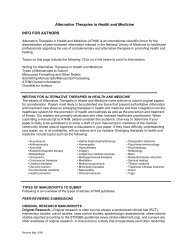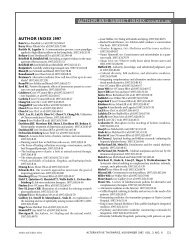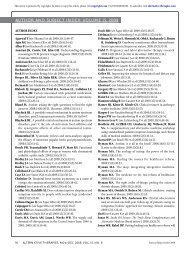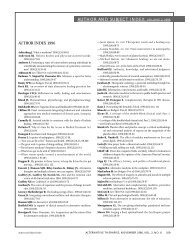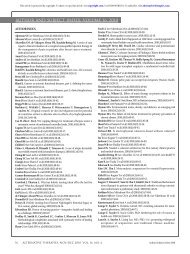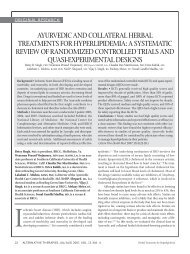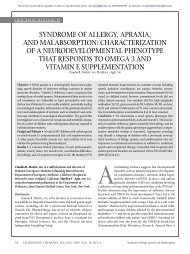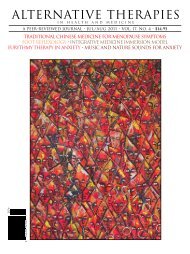Alternative Therapies In Health And Medicine
Alternative Therapies In Health And Medicine
Alternative Therapies In Health And Medicine
Create successful ePaper yourself
Turn your PDF publications into a flip-book with our unique Google optimized e-Paper software.
Some people may find IPT beneficial. IPT can be used to<br />
identify problem social situations that are depressogenic and to<br />
develop transpersonal techniques (such as social skills) to manage<br />
relationships. 84 By increasing confidence and competency in managing<br />
social interactions, a robust sense of self-esteem may develop.<br />
This approach may involve supportive group therapy, which is<br />
increasingly occurring via the <strong>In</strong>ternet (a method with emerging<br />
supportive evidence). 85 Referral to CBT <strong>In</strong>ternet programs such as<br />
MoodGYM (www.moodgym.anu.edu.au) provide a low-cost<br />
option for patients with <strong>In</strong>ternet access. Unemployment also<br />
increases the risk and duration of a depressive episode, 86,87 so discussion<br />
of the patient’s employment status in the therapeutic consultation<br />
and if appropriate, a referral (eg, to employment<br />
agencies) also may be of assistance.<br />
Spirituality is another important facet of the transpersonal<br />
element of the social component of the model that could potentially<br />
be termed a “biopsychosocio-spiritual” model. Religiosity<br />
and spirituality may provide a protective effect against depression.<br />
14 Though religion is a sensitive area (and should perhaps be<br />
left outside the therapeutic domain), the clinician can encourage<br />
patients to explore their spirituality and find existential meaning<br />
in the challenges of their depression. Another transpersonal element<br />
that may provide a simple euthymic effect is the act of<br />
altruism or kindness. Though people with significant depressed<br />
mood may find it difficult to engage in social connection, acts of<br />
helping others may increase self-esteem and provide a euthymic<br />
distraction from their melancholy. 14<br />
Clinical Considerations and Application of the Model<br />
From a clinical perspective, the goal of treating depression is<br />
to ameliorate the depression as quickly and safely as possible.<br />
During initial case taking, the clinician needs to assess the severity<br />
of the depression (ie, mild, moderate, or severe). The Diagnostic<br />
and Statistical Manual of Mental Disorders-IV (DSM-IV) assessment<br />
criteria can be used to diagnose MDD, 2 while an assessment<br />
scale such as HDRS may be used to determine the severity. An initial<br />
focus of case taking is to screen for suicidal ideation or plans<br />
to commit suicide. This is a major concern as suicide is a devastating<br />
potential consequence of MDD. 88 If suicidal ideation is significant<br />
or if self-harm is a distinct possibility at any stage, referral to<br />
a medical practitioner or to an emergency ward of a hospital for<br />
immediate psychiatric assessment is crucial.<br />
To treat depressed mood effectively, it helps to understand<br />
the biological, psychological, and sociological factors that are<br />
involved. As causations of depression are multifaceted, individual<br />
presentations vary markedly. The initial case-taking process is<br />
important to assess the causations of the depressive pattern<br />
(within a biopsychosocial framework); when the first episode<br />
occurred; the number of discrete episodes; the severity; what<br />
may trigger an episode (eg, anniversary of a death, change in the<br />
weather); maintaining factors that may exacerbate or prolong the<br />
episode (eg, ill health, chronic stress, unemployment); and what<br />
alleviates the depression. Comorbid medical conditions also may<br />
be causative factors of depression (and comorbid anxiety) and<br />
need to be screened for (eg, hypothyroidism, inflammatory disease,<br />
cancer, sleep disorders, heart or metabolic disease, or other<br />
psychiatric disorders). 89,90 Certain medications, such as corticosteroids,<br />
also may be implicated. 91 Substance or alcohol misuse<br />
also needs to be screened for, as this is commonly involved in the<br />
pathogenesis of depressed mood and also often occurs in<br />
depressed individuals who are trying to “self-medicate.” 65<br />
After thorough case taking, an individual tailoring of the prescription<br />
(within the financial means of the patient) is vital to<br />
address the specific underlying causes of the depression, thus<br />
assisting in compliance and recovery. After initial case taking and<br />
prescription, a follow-up appointment (approximately 1 week<br />
later if possible) is especially important not only to monitor for<br />
any lowering of mood but to ensure compliance, check for adverse<br />
reactions, and provide a supportive therapeutic role. At this time,<br />
the prescription can be modified accordingly, more elements of<br />
the ALPS model applied, and additional case-taking detail pursued.<br />
At any point of the therapy referral may also be required, as<br />
even the most skilled practitioners often cannot offer all the therapeutic<br />
interventions required to effectively treat the patient. Due<br />
to this, judicious referral may be of benefit for interventions such<br />
as psychology, acupuncture, social work, or exercise instruction.<br />
Figure 3 outlines a decision tree that may help in providing<br />
the clinician with a stepwise framework to treat MDD. The clinical<br />
decision of which interventions from the ALPS model should<br />
be used initially should be predicated upon the clinician’s judgment<br />
regarding the cause(s) of and likely solution(s) for ameliorating<br />
the depressive episode. <strong>In</strong> some cases, the underlying or<br />
sustaining cause may be obvious; however, in many cases a complex<br />
interplay between factors will occur, so an integrated<br />
approach to addressing these factors is advised. Though it is possible<br />
to develop a systematic approach based on an algorithm<br />
that recommends specific treatments for specific presentations, a<br />
“whole person” approach to treatment is usually a complex and<br />
individualized affair; therefore, it is ultimately up to the clinician—with<br />
the patient’s consent—to determine which interventions<br />
may be used and in what order they can be applied.<br />
<strong>In</strong>quiring about what has previously been beneficial in ameliorating<br />
the patient’s depressive symptoms may provide the<br />
most obvious signpost to potentially beneficial treatments. This<br />
may be reinstituted or adjusted as present considerations may<br />
require. Regardless of the clinician’s proposed treatment plan, it<br />
is important to give the patient a degree of the locus of control<br />
on the preferences and direction of his or her treatment. This<br />
may foster self-empowerment and self-reliance. It is also important<br />
to ensure that the treatment plan is aligned with the patient’s<br />
belief system. While a holistic integrative approach is advocated<br />
in this article, it is important not to overburden the patient with<br />
a myriad of interventions, as this may exacerbate the depressive<br />
episode. The most applicable primary intervention(s) can be<br />
instigated initially, and then over time other treatments can be<br />
offered at a pace that is comfortable for the person. There is<br />
growing evidence of the efficacy of this “stepped-care” approach,<br />
and although it is more costly, it has revealed improved outcomes<br />
An Evidence-based <strong>In</strong>tegrative CAM Model for Depression<br />
ALTERNATIVE THERAPIES, jul/aug 2011, VOL. 17, NO. 4 33



